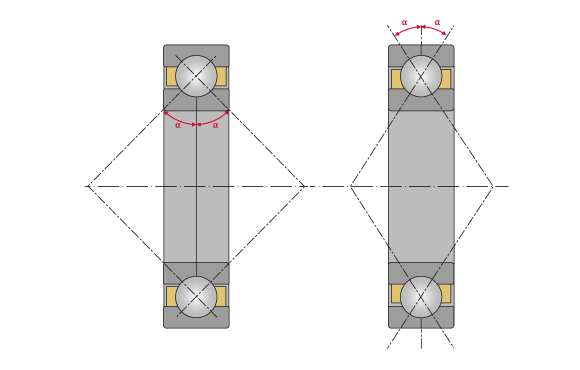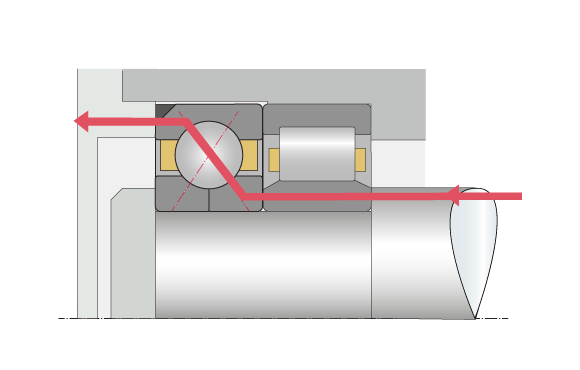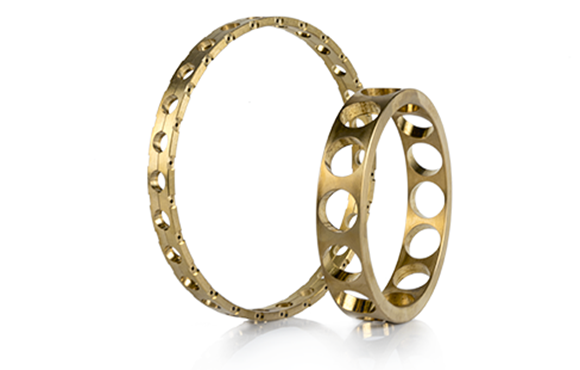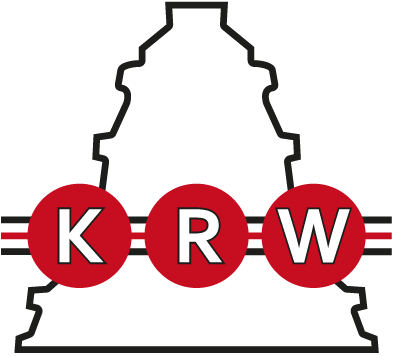
Four Point Contact Ball Bearings
metric
- Absorption of axial forces from both sides
- Absorption of low radial loads possible
- Designs with separated inner or outer ring possible

Four Point Contact Ball Bearings are a special type of single row angular contact ball bearings. They are capable of absorbing radial forces and axial forces on both sides due to a separated inner or outer ring which produces two contact angles and the eponymous four point contact. Four point bearings are often used as axial bearings and combined with a radial bearing. They can be disassembled but are non-latching and not suitable for compensation of angular misalignments.
Dimensions and Tolerances
KRW supplies four point contact ball bearings with normal tolerance (PN) in accordance to DIN 620-2 (Tolerances for roller bearings) and ISO 492 (Radial bearings - Dimensional and geometrical tolerances). All other deviating or special tolerances must be specified with the order.
Standards
The general dimensions of four point contact ball bearings are standardised by DIN 628-4 (Rolling bearings - Angular contact radial ball bearings - Four point contact bearing) for type QJ and based on the standard of TGL2982 for type Q. Dimensions and tolerances of the holding grooves are standardised by ISO 20515 (Radial bearings - holding grooves).

Bearing designs QJ and Q
Bearing Design
Four point contact ball bearings are dismountable and non-latching bearings that appear in two different designs. QJ bearings are the more common design and feature a divided inner ring and a contact angle of 35° (QJ12 series 45°). Q bearings consist of a divided outer ring and are manufactured with a contact angle of 23° (Q12 series 45°).

Axial load absorption in combination with a cylindrical roller bearing
The axial division of a bearing ring facilitates easy installation. Four point contact ball bearings can absorb high axial forces from both directions. The radial load capacity is often not used due to the elasticity of the divided ring. Four point contact ball bearings used as axial bearings should be provided with distinct radial clearance to the housing and installed directly next to the load-bearing radial bearing.
Bearing Clearance
KRW supplies four point contact ball bearings in normal clearance (CN) in accordance with ISO 5753-1 (Axial internal clearance for four-point-contact ball bearings), but they are also available in all clearance classes with restricted clearance or special clearance. Attention: Four point contact ball bearings only have axial clearing.
| ||||||||

Cage
By default, four point contact ball bearings by KRW are equipped with an outer flange riding solid brass window-type cage (suffix: MPA) for type QJ and with an inner flange riding solid brass window-type cage (suffix: MPB) for type Q. Other cage designs are available on request or chosen for specific applications and labelled accordingly on the bearing.
Suffixes
Compensation of Angular Misalignments
Four point contact ball bearings are not suitable for compensation of misalignments. Misalignments cause harmful ball movement and produce additional stresses in the bearing which reduce its operating life.
Speed
KRW distinguishes between kinematic limiting speed nG and thermal reference speed nth. The kinematic limiting speed is a practical mechanical limit value and is based on the mechanical fatigue strength of the rolling bearing as a function of its installation situation and lubrication. The limit speed must not be exceeded even under optimum operating conditions without prior consultation with KRW.
The thermal reference speed represents the equilibrium between the heat generated in the bearing by friction and the heat flow dissipated. It is standardised in DIN ISO 15312 (Rolling bearings - Thermal reference speed).
Admissible Operating Temperatures
The admissible operating temperature of a bearing is limited by cage material, dimensional stability of the bearing components (ball race and rolling elements), as well as lubrication. By default, KRW bearings are stabilised up to 200°C (S1). KRW provides roller bearings for higher operating temperatures on request.
Dimensioning
For dynamically loaded bearings
The service life formula according to ISO 281 L10 = (C/P)p for dynamically loaded bearings requires an equivalent load (P) from constant direction and size. To calculate P, calculation factors and the ratio of axial and radial load are required.
Equivalent Dynamic Bearing Load P
The equivalent bearing service life for four point contact ball bearings depends on the ratio Fa/Fr (axial force / radial force). The equivalent dynamic bearing load can then be determined using the following formula:

| P | equivalent dynamic load | [kN] |
| Fr | dynamic radial force | [kN] |
| Fa | dynamic axial force | [kN] |
| X | calculation factor, see chart | [-] |
| Y | calculation factor, see chart | [-] |
| Series | Fa/Fr | X | Y |
| Q | ≤ 0,67 | 1 | 0,66 |
| > 0,67 | 0,68 | 1,5 | |
| QJ | ≤ 0,95 | 1 | 0,66 |
| > 0,95 | 0,6 | 1.07 | |
| Q12../QJ12.. (45°) | ≤ 1,34 | 1 | 0,47 |
| > 1,34 | 0,54 | 0,81 |
Requirements for calucaltion:
- for type Q: Fa > 0,8 ∙ Fr
- for type QJ: Fa ≥ 1,2 ∙ Fr
For statically loaded bearings
Dynamic dimensioning loses its validity for bearings rotating at very low speeds (n x dm ≤ 4000 mm/min). The static load safety factor S0 is calculated as follows:

| S0 | static load safety factor | [-] |
| C0 | basic static load rating (from bearing chart) | [kN] |
| P0 | equivalent static bearing load | [kN] |
| n | bearning speed | [min-1] |
| dm | mean bearing diameter [dm = (D+d)/2] | [mm] |
Static load capacity
Type Q:


Minimum Axial Load
A minimum load is required for the reliable operation of a rolling bearing. If the minimum load is not reached, slippage may occur. The minimum axial load for four point contact ball bearings is roughly assumed to be 1% of the static load rating C0 of the bearing. If the value falls below this value, consult KRW Application Engineering.



